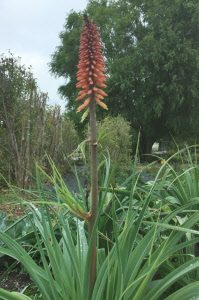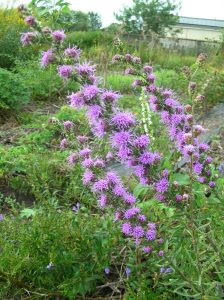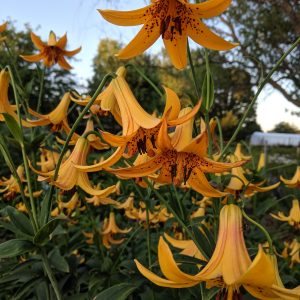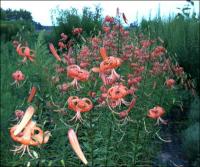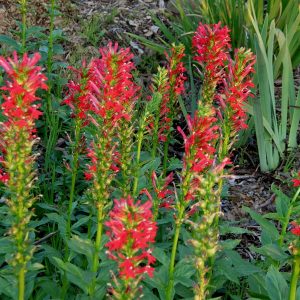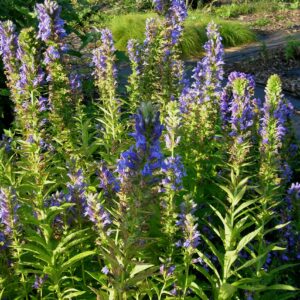Plants for Hummingbirds
Showing 41–48 of 82 results
-
Kniphofia caulescens Red hot poker, Regal torch lily Z 5-10
fat spikes of flowers open coral-red, turning pale lemon-yellow
OUT OF STOCK
Evergreen perennial with short, stout stems bearing grass-like broad, grey-green leaves. Blooming July to August, fat spikes of flowers open coral-red, turning pale lemon-yellow
Size: 3’ x 2-3’
Care: sun in moist well-drained soil
Native: Lesotho South Africa
Wildlife Value: deer and rabbit resistant. Attracts hummingbirds
Awards: Royal Horticultural Society Award of Garden Merit; Denver Botanic Garden Plant SelectIntroduced to gardens by Mr. T. Cooper about 1860. 1st described by French botanist Carrière in Revue Horticole in 1884
-
Kniphofia triangularis Dwarf Red hot poker Z 5-8
From early to late summer, with dead-heading, vivid coral spikes, like a torch .
OUT OF STOCK
In late summer and fall vivid coral spikes, like a torch.
Size: 2’ x 12-18”
Care: sun in moist to well-drained soil, Drought tolerant once established
Native: mountain grassland & moist areas in the Eastern Cape to the Northern province of South Africa.
Wildlife Value: resistant to deer & rabbits, feeds hummingbirds, bees and butterflies1st described in 1854 in Enumeratio Plantarum Omnium Hucusque Cognitarum: Secumdum familias naturales v. 4 p. 551..
-
Liatris aspera Rough blazing star Z 4-9
Feathery purple buttons along tall spike
OUT OF STOCK
Feathery purple buttons along tall spike in late summer: August-October, after all other Liatris are done flowering.
Size: 24”-30” x 12”-18”
Care: Sun in well-drained soil
Native: So. Canada, much of eastern 3/4th of U.S.
Wildlife Value: attract butterflies (favorite nectar for Monarchs and Buckeyes) & hummingbirds.Aspera is Latin meaning rough. 1st collected by Frenchman André Michaux (1746-1802) who spent 11 years in America collecting hundreds of new plants.
-
Lilium canadense, Z 2-6
Showy, drooping bell-shaped flowers from lemon to dark orange in color with conspicuous red spots on the inside
OUT OF STOCK
Showy, drooping flowers from lemon to dark orange in color with conspicuous red spots on the inside.
Size: 2-4’ x 6”
Care: part shade in moist to moist well-drained, slightly acidic soil
Native: Upper Great Lakes & southern Canada
Wildlife Value: attracts butterfliesIntroduced to gardens from its native North America by Jacques Cartier, 1535. Also collected by Swedish botanist Pehr Kalm (1716-1779) who collected in Northeastern US and SE Canada and sent it to Linnaeus. Grown at America’s 1st botanic garden, Elgin Botanic Garden 1811. Listed in the 1873 catalog of Leichtlin’schen Gartens in Baden-Baden.
-
Lilium lancifolium Tiger lily, in Japan called “oniyuri” Z 2-7
Late summer, orange, recurved blossoms with black spots
Late summer, orange, recurved blossoms with black spots
Can not ship to: Delaware and Maryland.
Size: 3-4' x 12"
Care: Sun to part shade in any soil
Native: AsiaLilium was named for the Greek word for smooth, polished referring to its leaves. The Tiger lily was in Chinese literature as long ago as the 10th century. The Chinese grew it in rows as a vegetable and wrote it brought the pained dragon to life. First described for the West by Englebert Kaempfer, physician to Dutch East India Co. on Deschema Island in the 1690’s. William Kerr sent the Tiger lily from Canton China to Kew in England in 1804. First Asian lily imported to America. A Tiger lily grew in Wonderland’s looking glass garden where it told Alice “We can talk…when there is anybody worth talking to.”
-
Lobelia cardinalis Cardinal flower Z 3-9
Ruby, cardinal red tubes with an upper lip split in half and a lower lip like a pixie’s apron encircle the spike up and down from August to October beckon hummingbirds to feed.
Ruby, cardinal red tubes with an upper lip split in half and a lower lip like a pixie’s apron encircle the spike up and down from August to October beckon hummingbirds to feed.
Size: 3’ x 12”
Care: sun to part shade in fertile, moist soil. Moist soil important
Native: Canada to Texas, Wisconsin native.
Wildlife Value: attracts hummingbirds
Awards: Received England’s Royal Horticultural Society Award of Merit & Missouri Botanic Garden Plant of Merit.Lobelia is named for Matthias L’Obel (1538-1616) French expatriate who immigrated to England and became physician to King James I. Cherokee cured stomach aches, worms, pain, fever, nose bleeds, rheumatism, headaches, colds and croup with Lobelia. They used the root to treat syphilis. In 1749 Swedish botanist Peter Kalm wrote that Indians used five species of Lobelia to cure venereal disease, “an infallible art of curing it.” Other Natives and colonists used the plant to induce vomiting. At the end of a funeral, Meskwaki Indians threw the dried and pulverized plant into the grave. Meskwaki also chopped the roots and secretly put it in the food of “a quarrelsome pair.” Allegedly “this makes the pair love each other again.” Tradescant the Younger (1608-1662) introduced this to European gardens when he sent it to England in 1637. Offered for sale in Bartram Garden’s 1783 Broadside. Grown by Washington at Mount Vernon and Thomas Jefferson at Monticello. Pressed specimen in Emily Dickinson’s herbarium.
-
Lobelia siphilitica ‘Alba’ z 4-8
Striking, erect spike of pure ivory blossoms opening from bottom up. On top club-shaped buds, below trumpet-shapes made of a tube flaring open at the ends with the top of the flare looking like a quarter moon with the circle at the bottom and the lower divided into three, each segment pointed at the ends. Its fresh white blooms stand out in late summer to early fall.
OUT OF STOCK
Striking, erect spike of pure ivory blossoms opening from bottom up. On top club-shaped buds, below trumpet-shapes made of a tube flaring open at the ends with the top of the flare looking like a quarter moon with the circle at the bottom and the lower divided into three, each segment pointed at the ends. Its fresh white blooms stand out in late summer to early fall.
Size: 2-3’ x 1-2’
Care: sun to part shade in moist or moist well-drained soil
Wildlife Value: Deer resistant, attracts bees, hummingbirds and some butterflies.This white one is “An albino of occasional occurrence.” Britton, Nathaniel Lord “On the Naming of ‘Forms,’ in the New Jersey Catalogue” Bulletin of the Torrey Botanical Club 17: 121,125. 1890. This may, therefore, be native in the same locations as the blue species or it may not.
-
Lobelia siphilitica Great lobelia Z 4-9
A striking, erect spike of sky to blueberry-blue blossoms. On top club-shaped buds, below trumpet-shaped, open flowers, made of a tube flaring open with the bottom divided into three, each segment pointed at the ends. From late summer to early fall.
A striking, erect spike of sky to blueberry-blue blossoms. On top club-shaped buds, below trumpet-shaped, open flowers, made of a tube flaring open with the bottom divided into three, each segment pointed at the ends. From late summer to early fall.
Size: 3' x 12"
Care: Full sun to part shade in moist to moist well-drained soil
Native: Connecticut to Wyoming, south to Texas then east to Georgia and all states in between, Wisconsin native.
Wildlife Value: attracts bumble bees, hummingbirds and some butterfliesLobelia is named for Matthias L’Obel (1538-1616) a French expatriate who emigrated to England and became physician to English King James I. Oneidas considered this good medicine for distemper. Sioux treated bloat, diarrhea and dysentery as well as a love charm by adding powdered root to the food of the intended. Cherokee used the root to treat headaches, stomachaches, worms, nosebleeds, colds and syphilis. 1st collected by Rev. John Banister (1649-1692) who moved to colonial Virginia in 1678. A gunman mistakenly shot and killed him while he collected plants. In 1749 Swedish botanist Peter Kalm wrote that Natives used five species of Lobelia to cure venereal disease, having “an infallible art of curing it.” According to John Bartram (1699-17760) “The learned Pehr Kalm (who gained the Knowledge of it from Colonel Johnson, who learned it of the Indians, who, after great Rewards bestowed on several of them, revealed the Secret to him) saith, That the Roots of this Plant cureth the Pox much more perfectly and easily than any mercurial Preparations, and is generally used by the Canada Indians, for the Cure of themselves.” (Better than mercury!) Offered for sale in Bartram Garden’s 1783 Broadside, America’s 1st plant catalog.

